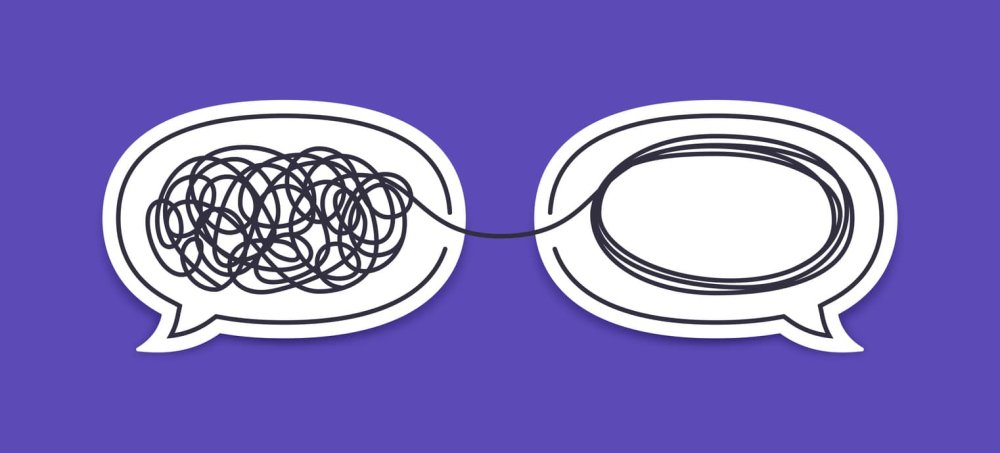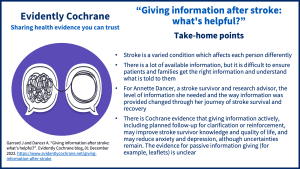James Garrard (Specialist Registrar in Stroke and Geriatric medicine) and Annette Dancer (stroke survivor and research advisor) give their reflections on giving information to people after stroke, and look at the evidence on what might be helpful for stroke survivors and their carers.
Take-home points
James’ experience as a doctor
As a doctor working in a busy stroke centre, when a patient with a new suspected stroke comes to hospital my focus is on making the diagnosis and working out if patients are suitable for any time-critical acuteA health condition (or episodes of a health condition) that comes on quickly and is short-lived. treatments. This involves detailed conversation about the timing of the symptoms, which medications have been taken, and the risks and benefits of the treatmentSomething done with the aim of improving health or relieving suffering. For example, medicines, surgery, psychological and physical therapies, diet and exercise changes.. Given that every minute delay in starting the treatment counts, this means conversations about ‘what happens next’ often must wait. It is only later that I can have a more detailed conversation with the patient and their loved ones.
Stroke is a varied condition and affects people differently
A stroke is a disruption to the blood flow to the brain, which causes a sudden loss of brain function. Unfortunately, that is where stroke as one condition for all patients ends.
Even the initial descriptions of what damage the stroke has done to the brain includes a huge variety in terms and descriptions. “An ischaemic stroke (stroke following a blocked blood vessel), a haemorrhagic stroke (from a burst blood vessel causing bleeding), left side of the brain, right side of the brain, back of the brain…”
That is before you begin to talk about how this has affected the person; “problems talking, problems walking, problems swallowing, problems co-ordinating movement”, which can affect any combination of brain functions.
And then there is the end effect on what this means for them. What is mild to me as a doctor, may be devastating for my patient. I remember one gentleman who was 98% back to normal within 1 month from his stroke but struggled with processing numbers. The issue was that, as an accountant, it meant he couldn’t work and had huge implications for the rest of his life.
We must do what we can to get it right when giving information
We, as healthcare professionals, must do what we can to get it right. From medical school and throughout training, you are taught to avoid medical jargon, give information in small chunks, and regularly offer a recap and the opportunity for questions. I know this is something I must continue to practise and improve on, and that it is my responsibility to make sure that the patient and their loved ones have understood what I say.
What evidence is there on how best to give information about stroke?
In the UK, patients are treated on dedicated stroke units, which include specialist management by specialist doctors, therapists, and nurses alike. Whilst these units have been shown to improve outcomesOutcomes are measures of health (for example quality of life, pain, blood sugar levels) that can be used to assess the effectiveness and safety of a treatment or other intervention (for example a drug, surgery, or exercise). In research, the outcomes considered most important are ‘primary outcomes’ and those considered less important are ‘secondary outcomes’. in a previous Cochrane ReviewCochrane Reviews are systematic reviews. In systematic reviews we search for and summarize studies that answer a specific research question (e.g. is paracetamol effective and safe for treating back pain?). The studies are identified, assessed, and summarized by using a systematic and predefined approach. They inform recommendations for healthcare and research. Organised inpatient (stroke unit) care for stroke: network meta‐analysis (published April 2020), it is likely that the information provision after stroke varies hugely between patient to patient, region to region. The Stroke AssociationA relationship between two characteristics, such that as one changes, the other changes in a predictable way. For example, statistics demonstrate that there is an association between smoking and lung cancer. In a positive association, one quantity increases as the other one increases (as with smoking and lung cancer). In a negative association, an increase in one quantity corresponds to a decrease in the other. Association does not necessarily mean that one thing causes the other. has published leaflets which are available online, to try and standardise some of the available information.
A Cochrane Review Information provision for stroke survivors and their carers (published November 2021) looked at the relative helpfulness of providing information to stroke survivors and their carers either Actively (for example, a combination of talks, demonstration, meetings or phone calls) or Passively (for example, a leaflet without any active follow up).
This review found that giving active information may help improve the knowledge of stroke and stroke care, may reduce symptoms of anxiety and depression, and may also improve the quality of life for patients after stroke, although the evidence is uncertain. The evidence for passive information is very uncertain. So there is much more that we need to know.
Annette’s experience as a patient and researcher
I had a brain stem stroke 8 years ago. My ongoing treatment is anti-platelet drugs.
The effects of my stroke are on my speech (dysarthria and aphasia), swallowing, coordination, balance, mobility.
I have a ‘car crash’ recollection of the weeks after the stroke. Retaining written information can be an issue for many stroke survivors.
In hospital I was given several leaflets regarding different aspects of stroke. A mixture of denial and disbelief on my part prevented me to a great degree from absorbing any information contained in the leaflets. I would even go so far as to say I was reluctant to read them as this would acknowledge the reality. I responded better to active information because it gave me the opportunity to ask questions. In my experience, in the early stages after stroke, active information and support, (especially for the carers, who are so heavily impacted by the whole stroke experience) is more effective than passive information. I believe there is benefit in both active and passive information in the later stages of stroke recovery too.
The impact of my stroke on others only occurred to me later. My primary carer was not given any support, advice, or information.
Looking back now, in the aftermath of a stroke, both the patient and the carer do not know what they need to know, and they are totally reliant on the information they are given.
I received about 6 weeks of occupational therapy/physiotherapy support then we were left to our own devices. We had to make it up as we went along – just rabbits in headlights.
Patients continually need to develop strategies to accept or overcome the residual effects.
Psychologically, stroke is a bereavement for all concerned
Something is lost. Who has the time/energy/concentration to sit down and read whilst trying to adapt to a critical, life-changing event? In my opinion, passive information is more likely to be absorbed after a period of mourning and adapting.
But active support requires resources. So, in the meantime, we muddle through with the help of research projects and Mr Google.
Taking part in research
I was keen to continue my rehabilitation beyond my 6-week treatment. Eventually, I sought out research projects online in order to get more information.
Research projects have been hugely instrumental in my physical and psychological progress. Not only did I discover more about stroke and how it affected me, but I felt useful and valued at a point when I thought I was useless. Regardless of degree of incapacity, surely involvement can only be beneficial. My mantra is “What have I got to lose?” I have gained so much access to information, and understanding one’s body has been half the battle.
The patient/carer perspective in research is also essential if treatment methods are to be impactful. I cannot recommend involvement in research enough.
My involvement over the last 8 years has led to me becoming a dysarthria research advisor to Dr Claire Mitchell at Manchester University. You can read more about that in our blogs: Sorry, what did you say? Living with dysarthria (unclear speech) after stroke and Research is better together: here’s why.
Are you interested in getting involved in research?
- The National Institute of Health Research page Be Part of Research has opportunities that you can search for by location and keyword (such as the name of a condition or treatment). LINK
- Cochrane Crowd is Cochrane’s citizen science platform. Anyone can join and no previous experience is necessary.
For more information and support on stroke:
- NHS Website pages on stroke
- Stroke Association
- Patient info Stroke leaflet
James Garrard and Annette Dancer have nothing to disclose



